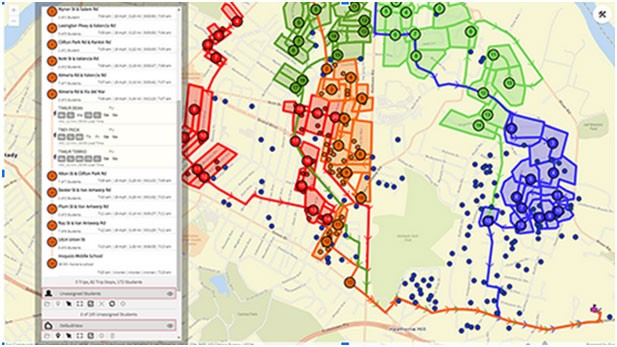
With an aging population of school bus drivers retiring, many schools find difficulty recruiting and retaining new drivers for their routes. Many districts adapt by reducing the number of buses and routes, leaving some children without a school bus option.
Good driver retention strategies, coupled with technology solutions like Transfinder, can prevent the loss of further bus routes and drivers, helping schools maintain high attendance and serve every child in their district to the best of their ability.
In the 2022 survey of School Transportation personnel, 67% said their district struggles to recruit new bus drivers.
From the same survey, 88% of respondents said that their transportation operations are affected by driver shortages. 40% said that driver pay affects driver shortages in their area, and 37% cited retiring drivers as a major issue affecting their driver numbers.
Chronic absenteeism in schools is a major problem that affects student futures across the country. Schools experiencing driver shortages, leaving students without a route to school, suffer increased absenteeism that interferes with their learning and future potential.

Image by Dimitris Vetsikas from Pixabay
Why is there such a high turnover rate among school bus drivers?
As many bus drivers enter retirement, retaining newly hired drivers is challenging for many districts. The reasons why school districts suffer from poor driver retention are numerous and range from drivers not having their basic needs met to feeling a lack of purpose and respect from the administration.
Understanding where districts are falling short is vital to forming strategies to create longer-term relationships with drivers in the future. Some of the most commonly noted reasons for high turnover are:
Low wages
In a 2016 study by the National Association of Student Transportation, 88% of school bus drivers and 89% of mechanics/maintenance technicians believed that the rate of pay is a major factor in the ability to recruit and retain school bus drivers.
At a time when the cost of living increases are soaring, many people are struggling to generate enough income for their basic needs. Low wages are a big factor in the battle to retain drivers when other driving roles are more competitive with both pay and the potential for wage increases in the future.
Although drivers cite many non-financial reasons why they choose to stay at a school district for the long term, cost of living increases are forcing drivers to consider pay rates as a top priority when selecting a job.
Irregular hours
Many school bus drivers work on a split shift schedule, with many working a morning shift and afternoon shift, with some hours break in between. Although some bus drivers use these hours to work in other roles, for many drivers the split shift model is inconvenient and contributes to a lack of retention.
Although many school bus driving roles are part-time, they are often not flexible and the staggered hours can create an issue for many people looking for part-time work in only the mornings, or the afternoons.
Stressful working conditions
In struggling school districts, shortages of drivers and a lack of effective policies can create extremely stressful conditions for drivers daily. Drivers often find themselves feeling powerless and stressed when experiencing the following:
- Last-minute route changes and irregularity, particularly in heavily trafficked areas
- Difficulty communicating with transportation school staff
- Administrative complaints about late arrivals despite longer and longer routes
- Behavior problems with students
- Ineffective administration communication with parents about schedules and route changes
- Lack of respect from school administrators
- No investment in helpful technologies to improve working conditions
By implementing technologies to help streamline communication, routing changes and suggestions, and student attendance many of the highly stressful situations drivers face are easily mitigated. Drivers appreciate the investment in their role, showing an understanding by the school district of the daily challenges they face.

Carli0809, CC BY-SA 4.0, via Wikimedia Commons
Impact of the turnover rate on the education system and student safety
Most districts impacted by bus driver shortages have responded to the problem by providing fewer bus routes to students, leaving some students without a bus option to get to school.
It is much more cost-effective to retain current employees than to repeatedly pay the costs for recruitment, administration, and training.
Strategies for Overcoming Workforce Challenges
A recent University of Albany study of drivers' motivations and retention strategies revealed that most drivers are more likely to stay in their positions for the long term when they feel like they are a true part of the education team.
Strategies for increasing driver retention should always be multifaceted and acknowledge that drivers have a range of needs and that no one strategy alone will fix the problem. The goal should always be to mold the role of school district bus driver into a position that meets the needs of drivers' lifestyles, financial obligations, health and safety, and feelings of happiness and belonging.
Drivers are an integral part of a school community, although sometimes felt unheard in the past, and can unlock huge potential for developing school administration policies focused on student success.
Some strategies for maximizing retention involve:
- Competitive compensation and benefits
- Flexible work schedules
- Improved working conditions
- Training and development opportunities
- Investment in technologies to improve outcomes and driver experience
- Recognition and rewards for service
Competitive Compensation and Benefits
Although many school districts, such as Brevard and Pinellas Counties in Florida, have recently instituted substantial pay increases to drivers in recruitment efforts, maintaining relationships over the long term needs to be a priority. These pay increases generate an abundance of local press interest to capture the attention of potential drivers.
Districts can consider increasing driver retention by engaging in negotiations with drivers around offering:
- Increased pay
- Sign-on bonuses payable after a set time of service
- Pay increases over time with years of service
- Pay for hours involving administrative planning and meetings
- Offering additional benefits such as medical, dental, vision, meal allowances, additional training, and flexible contracts
Flexible Work Schedules
School bus drivers often have different preferences for their work schedules. Some drivers are happy to work part-time hours or split shifts and complete personal errands or rest during the off hours.
Many prefer to have the option to increase their hours to full-time work by taking on other roles within the school. Providing this flexible approach to allow individuals to choose their preferred schedule helps to retain drivers.
Administrators can offer flexibility in terms of:
- Hours worked
- Job sharing
- Offering drivers additional roles within the school system
Improved Working Conditions
Working conditions are a major factor in the retention of school bus drivers.
Student behavior alone, and a lack of support around the issue can cause drivers to prematurely leave their positions, seeking other, plentiful driving jobs without these unique stressors.
In Milford, Massachusetts, the public school system implemented a “Bus of the Month” reward program, rewarding students with the most thumbs up for good behavior at the end of the month. This was a highly successful attempt to improve school bus behavior and in turn, working conditions for bus drivers.
This example of working with the drivers to improve outcomes shows how integrating bus drivers into the conversation is vital to understanding their needs and creating the best environment for students in the future.
Improving working conditions can involve ensuring that drivers:
- Feel Respected
- Are not overworked during their working hours
- Have enough support with planning and practical help when last-minute changes to bus routes occur.
- Can access the best tools for routing, student attendance, and communication with administrators.
- Are part of the discussion around ideas and policies to manage student behavior, which in turn allows for better monitoring of bullying and other concerning issues.
Training and Development Opportunities
Many drivers choose to work for the school district as they have an interest in education and the betterment of all people. These dedicated staff are often happy to take on other roles and further develop their positions within the school system, but many lack the formal training for further roles. Offering the following opportunities to drivers who choose to work within the education system can take advantage of the opportunity to develop people who have a keen interest in public service.
- Offering driver training for additional roles within the school system
- Allowing drivers to increase their paid hours by taking on other jobs within the school
- Including drivers in discussions surrounding school policies on behavior by acknowledging the unique insight, they gain into the students' behavior during transportation hours.
- Offering scholarships to further part-time education for drivers wishing to further study within the education system
Recognition and Rewards for Service
In the University of Albany study, most drivers felt they lack respect from the school administration. Suggestions for recognizing drivers as integral parts of the education team include:
- Highlighting drivers on school websites
- Including drivers in discussions surrounding studies of behavior policies
- Inviting drivers to participate in back-to-school evenings and allowing more interaction with parents
- Creating pay increase systems that reward years of service

Image via Transfinder
Role of Technology in Improving Retention
At Transfinder, we provide school bus drivers with technology options that improve driver experience, making their job easier and therefore helping with retention.
At Walton County School District in Florida, the past six years have seen a decrease in school bus drivers from 102 to 60. The Transportation Director, Dennis Grey, attributes the school's success, transporting a record number of students despite the drop in driver availability, to Routefinder. With Routefinder, this unique district can easily:
- Creatively modify, combine, and split routes
- Reduce the number of routes despite increasing the number of students
- Avoid any transportation-based shutdowns
- Make monitoring attendance an easy and stress-free task for drivers
- Allow open communication with administrators and create live information logs to record daily issues, providing actionable examples of any problems to resolve at future meetings.
Using Routefinder from Transfinder allows this school district to thrive, adapt, and lead the way in student transportation policies. Dennis Grey and his transportation team have reduced the number of daily bus trips from 350 to 176 by using Routefinder's advanced routing technology.
At a time when there is a long way to go in school policy changes to allow for thorough strategies in driver retention to take effect over the long term, technology can help to improve efficiency, driver conditions, and slow transportation loss in the present, leading into the future.
In Conclusion
During these pivotal years of development, it is crucial that students not only have an option of a bus route to school but that they experience consistency. For stability, students should feel that the district prioritizes their education and potential and can be relied upon to solve logistical issues around transportation.
By paying attention to the needs of drivers for pay, benefits, recognition, and stress reduction by providing seamless processes for bus drivers, schools can retain a greater number of drivers. Unfilled bus driver positions not only add to continuing problems arising from absenteeism but leave many positions empty for community members to become actively involved in the education and development of the next generation. There are many people who would love to be part of this crucial stage in students' lives, and working conditions should not be a barrier to this essential community connection.
By implementing state-of-the-art technologies like Routefinder, by Transfinder, many school districts find their transportation department completely transformed for the better, improving the lives of students, drivers, and school administrative staff who bear the responsibility of finding solutions to these problems.
Sources
- DRIVER RETENTION & THE CASE FOR A MODERN RETENTION PLAN - TransPar Group
- Tips for School Bus Driver Retention - 4ipta.org
- School of Ed Research Reveals Strategies to Retain School Bus Drivers - University at Albany
- Bus Monitors: Your Next Driver Retention Strategy? - School Transportation News
- Closing the Gap on Your School Bus Driver Shortage - stnonline.com
Featured Image via Deposit Photos # 295602272



